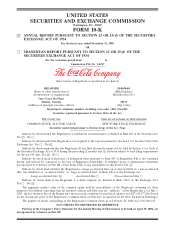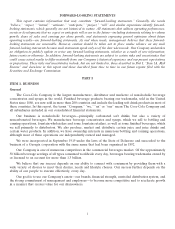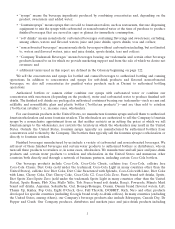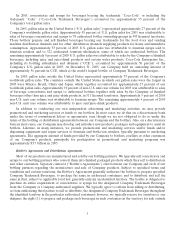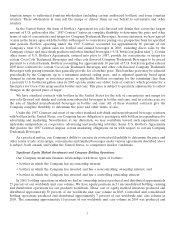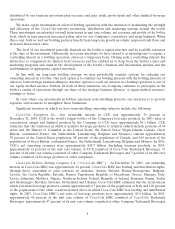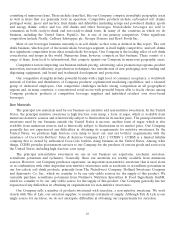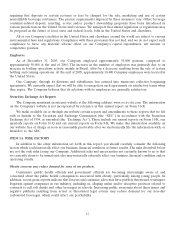Coca Cola 2005 Annual Report Download - page 6
Download and view the complete annual report
Please find page 6 of the 2005 Coca Cola annual report below. You can navigate through the pages in the report by either clicking on the pages listed below, or by using the keyword search tool below to find specific information within the annual report.Minute Maid juice and juice drinks, Simply Orange orange juice, Odwalla nutritional juices, Five Alive
refreshment beverages, Bacardi tropical fruit mixers concentrate (manufactured and marketed under a license
from Bacardi & Company Limited) and Hi-C ready-to-serve fruit drinks. We have a license to manufacture and
sell concentrates for Seagram’s mixers, a line of carbonated drinks, in the United States and certain other
countries. Our Company is the exclusive master distributor of Evian bottled water in the United States and
Canada and of Rockstar, an energy drink, in most of the United States and in Canada. Beverage Partners
Worldwide (‘‘BPW’’), the Company’s 50 percent-owned joint venture with Nestl´
e S.A. (‘‘Nestl´
e’’), markets
ready-to-drink teas and coffees in certain countries.
Consumer demand determines the optimal menu of Company product offerings. Consumer demand can
vary from one locale to another and can change over time within a single locale. Employing our business
strategy, and with special focus on core brands, our Company seeks to build its existing brands and, at the same
time, to broaden its historical family of brands, products and services in order to create and satisfy consumer
demand locale by locale.
Our Company introduced a variety of new brands, brand extensions and new beverage products in 2005.
Among numerous examples, we introduced Nanairo-Acha in Japan; Bonaqua BonActive in Hong Kong; and
new Fanta flavors including strawberry, pineapple and apple in Angola, Ghana and Nigeria, respectively. In
North America, we launched Coca-Cola Zero, a new calorie-free cola, Diet Coke Sweetened with Splenda brand
sweetener, Sugar Free Full Throttle; and Powerade Option, a new low-calorie, low-carbohydrate sports drinks.
We also rebranded our Fresca line and added two new calorie-free extensions—Sparkling Peach Citrus Fresca
and Sparkling Black Cherry Citrus Fresca. In Thailand and Vietnam we launched Minute Maid juice and juice
drinks under the Splash brand name. We extended the rebranding of Diet Sprite to Diet Sprite Zero/Sprite
Zero, which began in Greece in 2002, to now include a total of 77 countries, including the United States. In
2006, we launched Black Cherry Vanilla Coca-Cola, Diet Black Cherry Vanilla Coca-Cola, Full Throttle Fury,
Tab Energy and Coca-Cola Blak, a new Coca-Cola and coffee fusion beverage designed to appeal to adult
consumers, in France, and we plan to introduce this beverage in the United States later in 2006.
Our Company measures the volume of products sold in two ways: (1) unit cases of finished products and
(2) gallons. As used in this report, ‘‘unit case’’ means a unit of measurement equal to 192 U.S. fluid ounces of
finished beverage (24 eight-ounce servings); and ‘‘unit case volume’’ means the number of unit cases (or unit
case equivalents) of Company beverage products directly or indirectly sold by the Coca-Cola bottling system to
customers. Unit case volume primarily consists of beverage products bearing Company trademarks. Also
included in unit case volume are certain products licensed to, or distributed by, our Company, and brands owned
by Coca-Cola system bottlers for which our Company provides marketing support and from the sale of which it
derives income. Such products licensed to, or distributed by, our Company or owned by Coca-Cola system
bottlers account for a minimal portion of total unit case volume. In addition, unit case volume includes sales by
joint ventures in which the Company is a partner. Although most of our Company’s revenues are not based
directly on unit case volume, we believe unit case volume is one of the measures of the underlying strength of the
Coca-Cola system because it measures trends at the consumer level. The unit case volume numbers used in this
report are based on estimates received by the Company from its bottling partners and distributors. As used in
this report, ‘‘gallon’’ means a unit of measurement for concentrates (sometimes referred to as ‘‘beverage
bases’’), syrups, finished beverages and powders (in all cases, expressed in equivalent gallons of syrup) sold by
our Company to its bottling partners or other customers. Most of our revenues are based on gallon sales, a
primarily ‘‘wholesale’’ activity. Unit case volume and gallon sales growth rates are not necessarily equal during
any given period. Items such as seasonality, bottlers’ inventory practices, supply point changes, timing of price
increases, new product introductions and changes in product mix can impact unit case volume and gallon sales
and can create differences between unit case volume and gallon sales growth rates.
4

